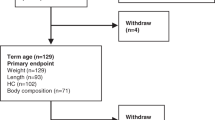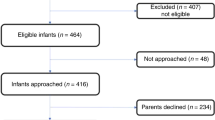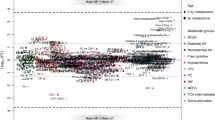Abstract
Objective: To assess the effects of birth size, growth and feeding in infancy on serum lipids in 12-month-old infants.
Design: A longitudinal observation study on infants' consumption and growth. Food and growth records were made every month. At 6, 9 and 12 months, food records were weighed to calculate intake. Serum total cholesterol (TC), high-density lipoprotein-cholesterol (HDL), low-density lipoprotein (LDL) -cholesterol and triglyceride concentrations were analysed at 12 months.
Settings: Birth and growth information was gathered from maternity wards and healthcare centres in Iceland and food consumption data at home.
Subjects: Randomly selected newborns (n=180) according to the mother's domicile and 77% (n=138) participated, of them 75% (n=103), came in for blood sampling.
Results: Among boys, a 1 kg higher birth weight resulted in a 0.79 mmol/l higher TC (P=0.005), but nonsignificant after adjustment for growth. Duration of breastfeeding was related to LDL-cholesterol (B=0.06 ±0.02, P=0.020, adj. R2=0.039), adjusting for gender. Independent of size at birth and breastfeeding, increase in length from 6 to 12 months and in weight from birth to 12 months were negatively related to TC (B=−0.455±0.156, P=0.008 and B=−1.086±0.474, P=0.032, respecitvely) in boys. PUFA was the strongest nutrient variable predicting TC (B=0.332, adj. R2=0.24, P>0.001). Cod liver oil consumption increased both TC and LDL-cholesterol in girls (B=0.141±0.051, P=0.008 and B=0.112±0.047, P=0.021, respectively).
Conclusion: Slower growth of high birth weight infants and breastfeeding contributes to higher TC concentration at the age of 12 months. Nutrient intake in infancy also affects lipid profile. The effect of birth weight, growth and nutrient intake in infancy on lipid profile is different for boys and girls.
Sponsorship: The Icelandic Research Council, Research Fund of the University of Iceland, Fund for Research Training and Graduate Education.
This is a preview of subscription content, access via your institution
Access options
Subscribe to this journal
Receive 12 print issues and online access
$259.00 per year
only $21.58 per issue
Buy this article
- Purchase on Springer Link
- Instant access to full article PDF
Prices may be subject to local taxes which are calculated during checkout


Similar content being viewed by others
References
Atladottir H & Thorsdottir I (2000): Energy intake and growth of infants in Iceland—a population with high frequency of breast-feeding and high birth weight. Eur. J. Clin. Nutr. 54, 695–701.
Austin MA (1999): Epidemiology of hypertriglyceridemia and cardiovascular disease. Am. J. Cardiol. 302, 1383–1389.
Barker DJP, Martyn CN, Hales CN & Fall CHD (1993): Growth in utero and serum cholesterol concentrations in adult life. BMJ 307, 1524–1527.
Berenson GS, Wattigney WA, Tracy RE, Newman WP, Srinivasan SR, Webber LS, Dalferes Jr ER & Strong JP (1992): Atherosclerosis of the aorta and coronary arteries and cardiovascular risk factors in persons aged 6 to 30 years and studied at necropsy (The Bogulusa Heart Study). Am. J. Cardiol. 70, 851–858.
Bertröm E, Hernell O, Persson LÅ & Vessby B (1995): Serum lipid values in adolescents are related to family history, infant feeding, and physical growth. Atherosclerosis 117, 1–13.
Bianchi C, Brambilla P, Cella D, Ragogna F, Tettamanti C, Puppo MD, Kienle MG, Chiumello G & Ruotolo G (1997): Influence of breast- and formula-feeding on plasma cholesterol precursor sterols throughout the first year of life. J. Pediatr. 131, 928–931.
Brown L, Rosner B, Willet WW & Sacks F (1999): Cholesterol-lowering effects of dietary fiber: a meta-analysis. Am. J. Clin. Nutr. 69, 30–42.
Butte NF, Wong WW, Ferlic L, Smith OE, Klein PD & Garza C (1990): Energy expenditure and deposition of breast-fed and formula-fed infants during early infancy. Pediatr. Res. 28, 631–640.
Cruz ML, Wong WW, Mimouni F, Hachey DC, Setchell KD, Klein PD & Tsang RC (1994): Effects of infant nutrition on cholesterol synthesis rates. Pediatr. Res. 35, 135–140.
Daily recommendations in Iceland (Radlagdir dagsskammtar, RDS) (1996): leaflet/script, The Icelandic Nutritional Council.
Fall CHD, Barker DJP, Osmond C, Winter PD, Clark PMS & Hales CN (1992): Relation of infant feeding to adult serum cholesterol and death from ischemic heart disease. BMJ 304, 801–805.
Friedewald WT, Levy RI & Fredrickson DS (1972): Estimation of the concentration of low-density lipoprotein cholesterol in plasma, without use of the preparative ultracentrifuge. Clin Chem. 18, 499–502.
Friedman G & Goldberg SJ (1975): Concurrent and subsequent serum cholesterol of breast- and formula-fed infants. Am. J. Clin. Nutr. 28, 42–45.
Freedman DS, Srinivasan SR, Cresanta JL, Webber LS & Berenson GS (1987): Serum lipids and lipoproteins. Pediatrics 80, 789–796.
Gunnarsdottir I, Birgisdottir BE, Benediktsson R, Gudnason V & Thorsdottir I (2002a): Relation between size at birth and hypertension in a genetically homogenous population of high birth weight. J. Hyperten. 20, 623–628.
Gunnarsdottir I, Birgisdottir BE, Thorsdottir I, Gudnason V & Benediktsson R (2002b): Size at birth and coronary heart disease in a population of high birth weight. Am. J. Clin. Nutr. 76, 1290–1294.
Haust MD (1990): The genesis of atherosclerosis in pediatric age-group. Pediatr. Pathol. 10, 253–271.
Huttunen JK, Saarinen UM, Kostiainen E & Siimes MA (1983): Fat composition of the infant diet does not influence subsequent lipid levels in man. Atherosclerosis 46, 87–94.
Kalen A, Appelkvist EL & Daliner G (1989): Age-related changesin the lipid composition of rat and human tissues. Lipids 24, 579–584.
Kallio MJT, Salmenperä L, Siimes MA, Perheentupa J & Miettinen TA (1992): Exclusive breast-feeding and weaning: effect on serum cholesterol and lipoprotein concentrations in infants during the first year of life. Pediatrics 89, 663–666.
Kallio MJT, Salmenperä L, Siimes MA, Perheentupa J & Miettinen TA (1993): Tracking of serum cholesterol and lipoprotein levels from the first year of life. Pediatrics 91, 949–954.
Kannel WB, Castelli WD, Gordon T & McNamara PM (1971): Serum cholesterol, lipoproteins, and risk of coronary artery disease. The Framingham Study. Ann. Intern. Med. 74, 1–12.
Karlsland Åkeson PM, Axelson IEM & Räihä NCR (1999): Plasma lipids and apolipoproteins in breastfed and formula-fed Swedish infants. Acta Paediatr. 88, 1–6.
Kromhout D (2001): Epidemiology of cardiovascular diseases in Europe. Public Health Nutr. 4, 441–457.
Lapinleimu H, Viikari J, Jokinen E, Salo P, Routi T, Leino A, Ronnemaa T, Seppanen R, Valimaki I & Simell O (1995): Prospective randomised trial in 1062 infants of diet low in saturated fat and cholesterol. Lancet. 345, 471–476.
Li JR, Bale LK & Kottke BA (1980): Effect of neonatal modulation of cholesterol homeostasis on subsequent response to cholesterol challenge in adult guinea pig. J. Clin. Invest. 65, 1060–1068.
Mize CE, Uauy R, Kramer R, Benser M, Allen S & Grundy SM (1995): Lipoprotein-cholesterol responses in healthy infants fed defined diets from ages 1 to 12 months: comparison of diets predominant in oleic acid versus linoleic acid, with parallel observations in infants fed a human milk-based diet. J. Lipid Res. 36, 1178–1187.
Morley R, Harland PSEG, Law CM & Lucas A (2000): Birthweight and social deprivation: influences on serum lipids and fibrinogen. Acta Paediatr. 89, 703–707.
Owen CG, Whincup PH, Odoki K, Gilg JA & Cook DG (2002): Infant feeding and blood cholesterol: a study in adolescents and a systematic review. Pediatrics 110, 597–608.
Reiser R & Sidelman Z (1972): Control of serum cholesterol homeostasis by cholesterol in the milk of the suckling rat. J. Nutr. 102, 1009–1016.
Reiser R, O'Brien BC, Henderson GR & Moore RW (1979): Studies on a possible function for cholesterol in milk. Nutr. Rep. Int. 19, 835–849.
Rifai N, Warnick GR, McNamara JR, Belcher JD, Grinstead GF & Frantz IDJ (1992): Measurements of low-density-lipoprotein cholesterol in serum: a status report. Clin. Chem. 38, 150–160.
Ripsin CM, Keenan JM, Jacobs DR Jr, Elmer PJ, Welch RR, Van Horn L, Liu K, Turnbull WH, Thye FW, Kestin M, Hegsted M, Davidson DM, Davidson MH, Dugan LDD, Denmark-Wahnefried W & Beling S (1992): Oat products and lipid lowering: a meta-analysis. JAMA 267, 3317–3325.
Sporik R, Johnstone JH & Cogswell JJ (1991): Longitudinal study of cholesterol values in 68 children from birth to 11 years of age. Arch. Dis. Child. 66, 134–137.
Stary HC (1989): Evolution and progression of atherosclerotic lesions in coronary arteries of children and young adults. Arteriosclerosis 9(Suppl. I), I19–I32.
Wong WW, Hachey DL, Insull W, Opekun AR & Klein PD (1993): Effect of dietary cholesterol on cholesterol synthesis in breast-fed and formula-fed infants. J. Lipid Res. 34, 1403–1411.
Ziegler B, Johnsen SP, Thulstrup AM, Engberg M, Lauritzen T & Sorensen HT (2000): Inverse association between birth weight, birth length and serum total cholesterol in adulthood. Scand. Cardiovasc. J. 34, 584–588.
Acknowledgements
We thank Hildur Atladottir, nutritionist, for her valuable help in the data collection, and the staff in the laboratories at Landspitali-University Hospital in Reykjavik, Iceland.
Author information
Authors and Affiliations
Corresponding author
Rights and permissions
About this article
Cite this article
Thorsdottir, I., Gunnarsdottir, I. & Palsson, G. Birth weight, growth and feeding in infancy: relation to serum lipid concentration in 12-month-old infants. Eur J Clin Nutr 57, 1479–1485 (2003). https://doi.org/10.1038/sj.ejcn.1601714
Received:
Revised:
Accepted:
Published:
Issue Date:
DOI: https://doi.org/10.1038/sj.ejcn.1601714
Keywords
This article is cited by
-
Fish Oil Supplementation During Late Pregnancy Does Not Influence Plasma Lipids or Lipoprotein Levels in Young Adult Offspring
Lipids (2011)
-
Dietary fat in infancy should be more focused on quality than on quantity
European Journal of Clinical Nutrition (2008)
-
Relationship between growth and feeding in infancy and body mass index at the age of 6 years
International Journal of Obesity (2003)



